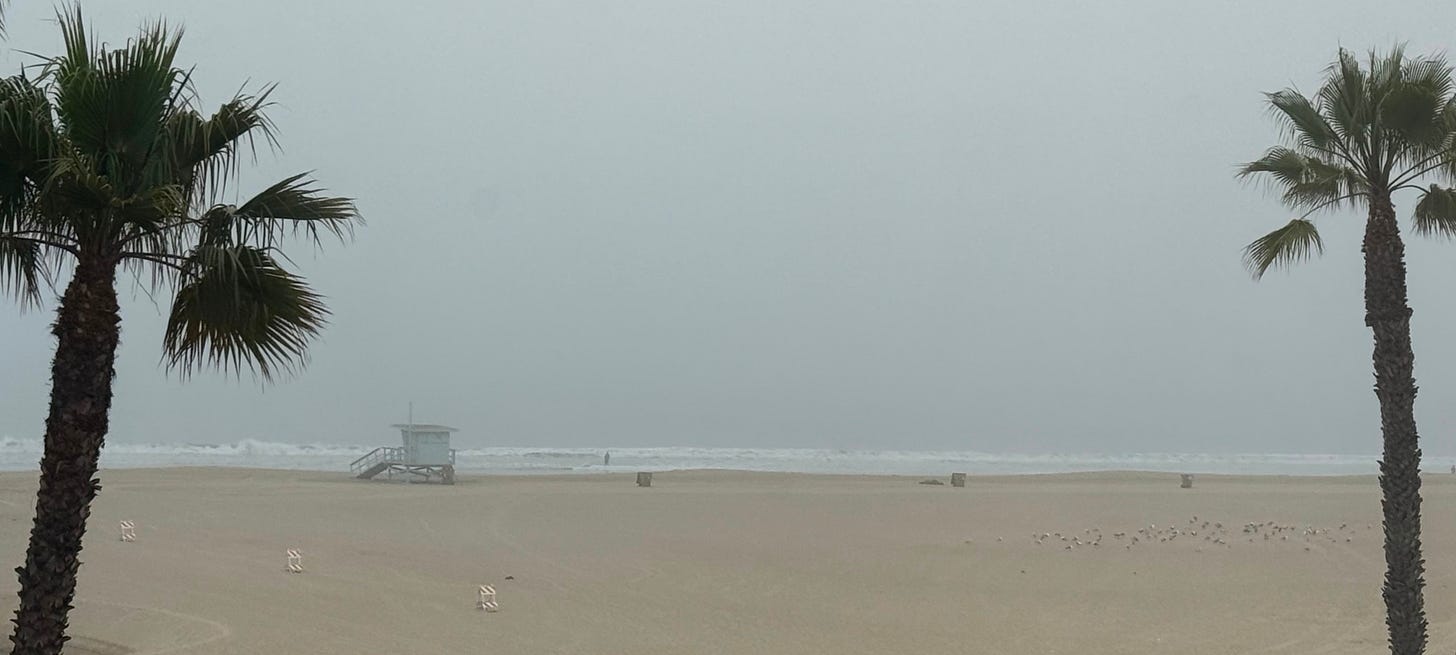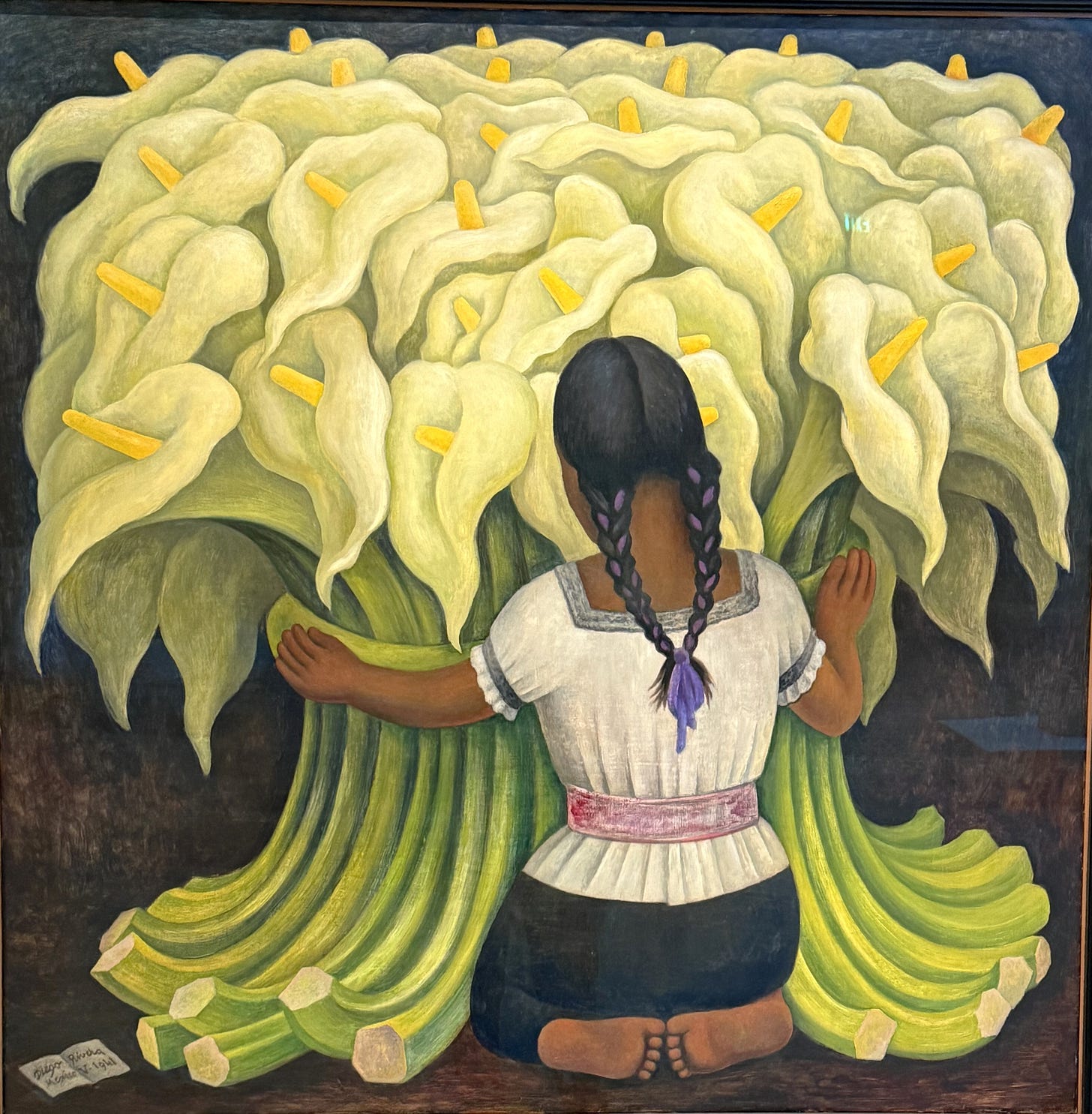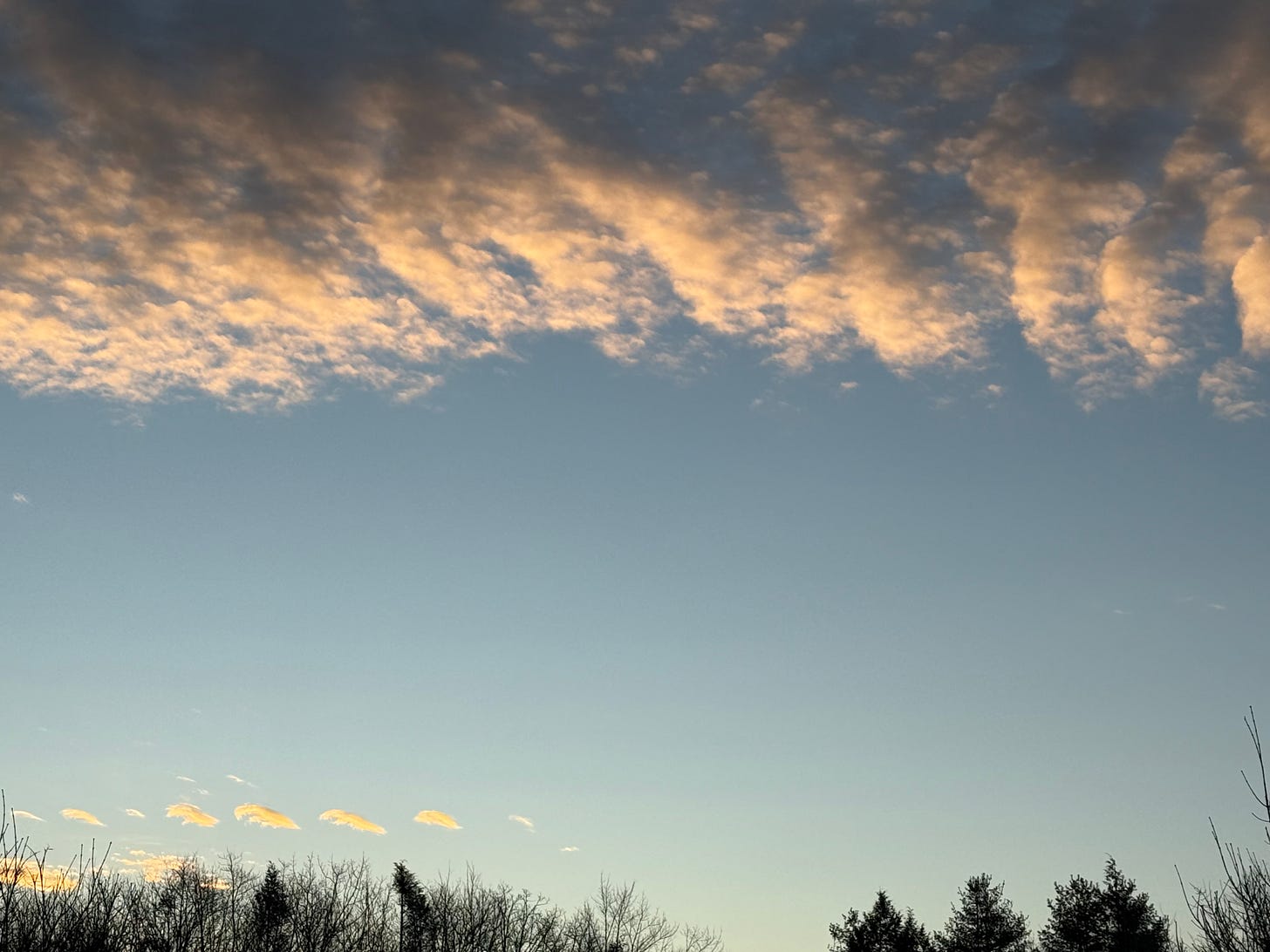I have been thinking about a previous post where I wrote that I wouldn't move on. I believe it's time to move on now, regardless of how difficult it may be.
Ensconced in my hotel room here on Santa Monica beach, experiencing what they call June gloom here, even though it’s at the end of May, where the coastline is shrouded in a warm grey fog. It all feels somehow right, if not a bit unsettled, and a challenging situation to find oneself in. But still good in many ways too. I suppose it's the yin and yang of experience.
Yesterday, it was gloriously sunny (hot even, it was a 100 degrees in the LA basin, crawling through downtown Los Angeles traffic), I was running around Los Angeles in the warm sunshine, talking to myself occastionally, chatting with bartenders, and an old friend at dinner, having cars cut in front of me entering the freeway system, experiencing the rules of traffic in LA once again (go as fast as the car in front of you, keep close but not too close) and expect delays at the intersections of the freeways from way too many cars. I felt alive again to be on this side of the country; I had returned to a place that had changed, but was the same in its essence. I recognized landmarks, the names of the streets, and their celebration of Spanish explorers and colonizers. LA (sometimes referred to as the Capital of the Third World) is a wonderful, vast, and exciting place with diverse cultures and people. People are generally nice to each other here, but they don’t invade your personal space or interfere with your business; they mind their own affairs, and the expectation is that you will do the same and refrain from judgment. Sharing the lightness of being and laughing about what can’t be changed.
View from Casa Del Mar, Santa Monica, May 2025
Now, it's like being held in a visual prison of grey; there are no blues at all. The Pacific is a grey carpet, and there is no horizon to be seen, and even the palm trees, without the offshore breeze, look desolate. A good time to sit here at my desk in the hotel, order a latte, yogurt, fruit, and an egg white omelette with porcini mushrooms and kale (Oh, so very California cuisine), as I pen these words to share with you and make sense of the now.
As Sue was dying, as I and the staff of over 20 different caregivers who were taking care of her, I was at the same time attempting to prepare myself for the time after. While the physical work involved in caring for her was considerable, the ongoing emotional work was even more demanding. And the continuing impact, in ways large and small, is extremely difficult in ways hard to imagine unless you, too, have gone through something like this. A friend commented that I would have to grieve the end of our life together, which was just a part of the truth of the reality and finality of a change so monumental when a person’s life ends. Objects, ephemera, that filled our house, are a continual reminder of what was no longer to be. Looking at her as she slowly wasted away was devastating, but I could not acknowledge it at the time, and while these memories make me cry with hurt now, remembering how it was, as the time and distance lengthen, feelings become softened in some ways and sharper in others.
During the last 3 months of her life, in an attempt to make sense of, organize the memories, I gathered together and read her day-to-day writing and journals, her Master’s thesis from Yale on help seeking behavior, her 2 volume dissertation on a behavioral intervention for children with special needs, her papers in academic journals, the books from leading a huge team from the Disease Management Association of America to create definitions, guidelines, to govern the development of systems of care and integrate health care delivery for chronic diseases.
But that was just her work life, there were presentations that she developed as President of the Calabasas Historical Society, such as her series of lectures on the ‘Park Moderne,’ a group of houses built in the Santa Monica mountain foothills above the orange groves and ranches of the San Franando Valley in the beginning of the 20th century (before it became the suburb of LA that we see today). Houses built by refugees arriving from the Nazi ethnic and ideological cleansing before WWII - built during the belle epoque period, a flowering of ideas in literature, art, music, and architecture that was the beginning of ‘modernism’ and what we now think of the modern world. Documents and photos of her volunteer work as the president of the docents organization of Malibu Creek State Park, her chairmanship of the westhills Firesafe Council, and her participation in the Brandeis Book Group. Our community garden at Orcutt Ranch (which I will discuss in more detail at some point).
Then, from our time in Maine, there was a plethora of art books and collage art that she created, as well as our photo albums of trips and adventures around the world, including hundreds of photographs taken before we moved to Maine and throughout our life together. Additionally, we often created written or artistic messages to share with each other, quotations that we found stimulating, or nuggets of information about a wide range of topics. Then too, there were photographs of holidays and events, small and large from both our lives, some previous to our meeting at BU that fatefull day, 43 years ago, and much more from during our long years of partnership; there were yearbooks from her high school at New Trier, college at Carleton and her years of teaching middle school in Missouri, and teaching in Connecticut’s special school for children. In other words, a lot, a lot of stuff. A very big amount of stuff. An overwhelming collection.
I decided to create a collage of her life, editing it down by cutting out pictures of her, us, and memorable places, as well as other people. I integrated a selection into her artbooks, discarding the chaff and retaining the essence (or, in my perception of what should be kept and what should be discarded). Assembling it all, having an order but spreading it not in a directly linear fashion across her artbooks, in an attempt to communicate the richness of our time together as a couple who worked together to forge an interesting and fulfilling life. In addition to fostering an understanding of her life and our life together, this also became a series of documents and a form of therapy for me.
The life and times that we saw and experienced, whether alone, together, or with others, were the rhythm of us. We discussed aspects of it almost every day of our time together, because our life revolved around understanding each other and the world we lived in.
The contrasts between Maine and Santa Monica have been present in my mind as I write this, each place weaving its own kind of narrative into our lives together and now apart. Art became an increasingly important and growing aspect of our relationship and lives. For example, Diego Rivera’s exceptionally beautiful and arresting painting below, which I just saw again in the museum where it resides (instead of the poster above our bed) inspired to us to go to Mexico to hike in the colonial silver mining cities of the north and spend time in Mexico City searching for more of his murals. It was an adventure to discover the real underpinnings of California and other art from a culture that we lived alongside with in California. Where it was the majority culture, and we were the Anglo minority. It creates a vastly different dynamic for civil society than the rest of the US.
Diego Rivera, Norton Simon Museum, Pasadena
Maine, with its rugged and beautiful coastline, is home to a small population, many of whom disdain one group or another, has a predominantly older population, and a monotonic culture. Full of old and staid communities, it is a world apart from the vibrant, interconnected mosaic that is LA. As I packed my bags and prepared to leave behind the muted hues of the East (and the last three weeks of rain and no sunshine), I was drawn not only by memory but by an aching need to rediscover the pulse of a life once lived in technicolor, not as a memory of times ago, but as a living goal that I would try to create every day.
After over a year of anguish and various attempts to recover from the iatrogenesis of a medical procedure, Sue died on April 29th of this year. The last several months have been excruciating and exhausting in many ways - emotionally, physically, and just plain awful. To use a quote from Didion - Sue ‘had the instincts of a refugee, never look back.’ And for that matter, don’t obsess over the spilled milk; clean it up and move on. Consider creating a better future and strive to make it a reality. Get on with it; I can see her rolling her eyes, signaling to me to stop talking about her death and discuss something more interesting and pleasant, so I will.
So I have flung myself across the continent, returning to Santa Monica, California, where we moved at the end of 1989. Sue was recruited to Value Health Sciences, and I found a job at the RAND Corporation. We have many friends here, a lot more than we made in the East (because we lived here for 25 years). I had dinner at the Blue Plate Oysterette on Ocean Avenue in SM with two of them the other night, one a consultant, the husband & former coworker at Amgen, now a consultant to the health care industry (should I put that phrase in scare quotes? — probably, as it seems the industry is swirling around the drain right now), trying to get to retirement and do some good work along the way, the other a distinguished professor at the School of Public Health at UCLA, she was returning from a conference, and as we sat on Ocean Avenue discussing social theory, health care, intergenerational wealth transfer in Los Angeles among different ethnic groups and the impact of the recent fires, my death journal and experiences of the last two years, it felt like I had never left LA over a decade ago.
The complexities of LA, gender, ethnicity, and health care delivery, not to mention theories of social cohesion and change, were all fodder for a lovely evening enjoying fish, oysters, and the sunset over the Pacific.
Santa Monica Pier Ferris Wheel at sunset, Santa Monica mountains in the distance, May 2025
The dinner was a bit noisy, being outside on Ocean Ave., the food was good, and the conversation threads were thoughtful and intelligent, laced with empathy and understanding, to make the world a better place for everyone, not just the elite. While we did cover my disappointments with the medical care Sue received from Dana-Farber, and the lack of care-giving staff at the bottom rungs of the healthcare delivery systems, a necessary foundation for quality care delivery, it was good. Poor reimbursement leads to staffing shortages, which in turn result in poor quality of care. More about trying to understand what the causes of the dysfunctions we are all observing in American society are, and how we could address them. While people want simple solutions, they all come at a cost, which no one wants to bear.
I want to see them again, ask about their kids, and learn about how they're doing in the world. And while they seemed grayer and older, so was I. Not enough time to catch up on everything I've missed over the last decade, but perhaps enough time to begin a reconnection.
I have just finished reading Didion’s novel, Democracy, this evening as I finish this post. The book was published in 1984 and is set in a specific time and place — the beginning of the decline of the United States Empire. A narrative written about how politics (international and national), money, the political class, business interests, and wars (conflicts such as Vietnam, but Southeast Asia in particular, — remember the movie — A Year of Living Dangerously, about the Indonesian conflagration) all intersect with the personallife, which are in particular places, and times of history. Didion offers sly and snarky observations about the ways in which media of the period capture slices of reality with a changing narrative, not of the reality itself, but of society’s view of its meaning for public consumption. Additionally, there are sly digs concerning the manners and morality of the 1970s.
But what struck me was her writing about color, a topic which I am very interested in these days.1 (transparent blues in particular) as a reason to live in a particular place on the globe, and her unsentimentality about death and dying. She had such a way with language and words.
“Colors, . . . Enough blue in the air.” and “The sun still rises and you still don’t see it.”
Sunrise, Maine, April 2025
Peace and love to you all. Keep up the fight; the next generation will need our help.
Joel
In a future post and a series of essays, you will get reviews of Wittgenstein’s Remarks on Color, discussions on color theories, and the science of the perception of color.









Thank you for sharing part of your journey Joel and especially these final months of life with Sue covering four(+) decades of time and memories together. I can imagine that it might be soothing and invigorating to be immersed in a technicolor culture out in Santa Monica -- life is pretty monotone-ous here in rugged Maine, as you have observed and experienced. I appreciate your sense of digging deep to find the energy to imagine and live out another chapter somewhat revisiting previous ones.
Having "retired" fairly recently I was not and am still not well prepared at all for what's next and am not sure that there will be any grand gestures or big moves for me. I am enjoying playing bar trivia a couple times a week, one night with family and another with neighbors up at Sabbathday Lake where I live. I haven't gotten much further than that.I have a summer on the lake ahead of me with my accidentally largest pontoon boat on the lake for one which I fortunately figured out to share with my neighbors which has been a treat for everyone. And hopefully I'll get into my daily swim routine soon (I haven't tested the water temp yet). I have had a rich career of developing exciting creative projects here in the Portland area for the past 40 years and I don't know if I have another round in me.
So to read about your big leap is intriguing and inspiring. And you carry a very deep process with you as you return to familiar haunts that hopefully won't feel particularly haunting. It sounds like you have a rich life ahead of you with dear friends and exciting and non-monotonous surroundings and activities. I will borrow a bit of your initiative and energy as I look forward.
Very best wishes to you, Joel. I have appreciated our short visits together. I guess you'll have to change the title of your sharings! Not sure if you'll be able to put together such a great alliterative title -- Monica Missives could be a bit confusing -- especially to Monica, whoever she is!
Yer pal Kal
Thank you Joel. I enjoy your writing... nothing wrong with moving on. Having consciously moved on several times from different things, I've come to think of my life as a continual move. Just hope to always move forward!